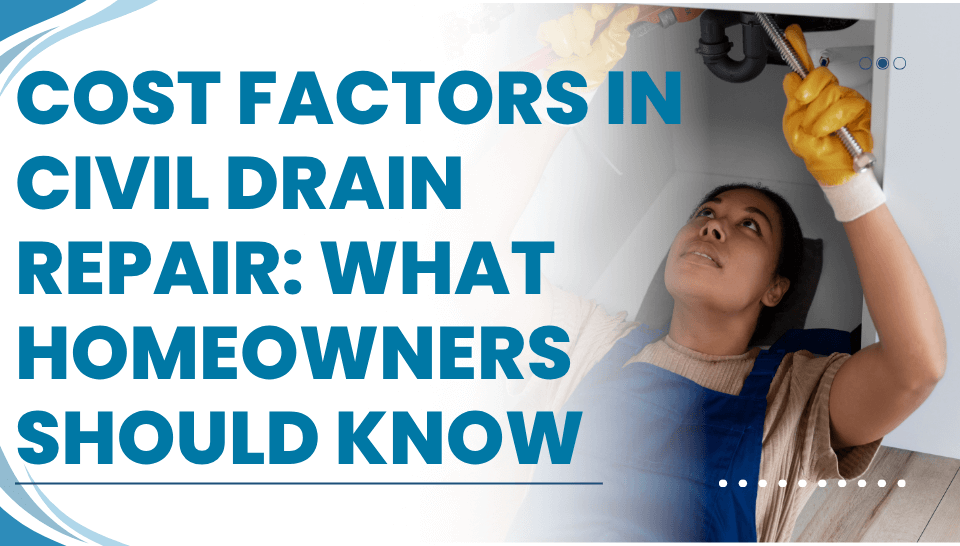
When a drainage issue strikes, the first concern for most homeowners is cost. Knowing the key factors that affect civil drain repair costs helps you make smart choices. This helps you avoid unexpected costs. It also ensures your drainage system is fixed correctly.
In this guide, we’ll look at what impacts drain repair costs in the UK. We’ll also cover what to expect during repairs. Plus, you’ll learn how to maintain your drainage system without overspending.
Understanding the Basics of Civil Drain Repair
Civil drain repair includes services to fix damaged, collapsed, or blocked drains. These services are vital for homes and businesses. They help stop flooding, protect property, and avoid structural problems.
Before we break down the costs, it’s important to know that every situation is unique. The cost of drain repair services varies. It depends on factors like the type of damage, location, access, and the chosen repair method.
Key Factors That Influence Civil Drain Repair Cost
1. Type and Extent of Damage
The severity of the problem plays a major role in determining cost.
- Minor blockages or cracks can often be fixed using non-invasive techniques like relining.
- Excavation may be needed for severe damage, like collapsed pipes or root intrusion. This can be expensive.
2. Location and Accessibility
If the damaged drain is under concrete, driveways, or gardens, it’s hard to access. The harder it is to access the affected area, the more expensive the drain repair will be. This is because it takes more time and effort.
3. Drain Depth and Pipe Size
Deeper drains and larger-diameter pipes require more effort, equipment, and materials for repair. This adds to the total drainage repair estimate.
4. Method of Repair
Different repair methods come with varying costs:
- CCTV drain survey cost before repair: A professional survey usually costs £100–£250. This survey is key for finding the problem accurately.
- Drain relining: A trenchless, affordable option that can cost between £80–£120 per metre.
- Excavation and replacement: This common method costs about £150–£250 per metre. The price varies with complexity and materials.
5. Labour and Equipment
Skilled technicians and advanced tools lead to lasting results. However, they also raise the average cost of drain repairs. Choosing a reputable company ensures quality work that prevents future issues.
6. Emergency vs. Scheduled Repairs
Emergency callouts due to sudden collapses or blockages can increase costs. Planning maintenance or early intervention helps you find affordable drain repair services. This way, you avoid extra urgency charges.
Why a CCTV Drain Survey Is Essential Before Repair
A CCTV drain survey shows what’s inside your drainage system. It helps technicians find cracks, blockages, and other problems without digging.
Benefits include:
- Accurate diagnosis before starting any repair work
- Prevents unnecessary digging and extra costs
- Helps you get a transparent drainage repair estimate
- Reduces the risk of recurring issues
A survey before starting work ensures the civil drain repair cost fits the real issue. This way, it’s based on facts, not guesses.
Comparing Drain Relining vs. Excavation Costs
Choosing between relining and excavation depends on the condition of the pipes:
Method Description Cost Estimate (per metre) Best For
- Drain Relining Non-invasive method using resin to create a new pipe inside the old one. £80–£120 Minor cracks, root intrusion, or leaks.
- Excavation & Replacement Complete removal and replacement of damaged pipes. £150–£250 Collapsed or severely damaged drains.
Trenchless drain repair is often quicker and less expensive. Still, excavation is sometimes required, especially when structural integrity is at risk.
Example: Real-Life Cost Scenario
A homeowner in South London recently noticed slow-draining sinks and foul smells. A CCTV drain inspection revealed a cracked pipe and partial blockage. C4Plus Drainage suggested CIPP relining. It costs about £1,000 for a 10-metre section.If we had ignored the issue, the cost for a full excavation and drain replacement could have topped £3,000. We also would have faced landscaping repairs. Early intervention and modern repair methods save time and money in this case.
Tips to Manage Drain Repair Costs
- Schedule regular CCTV surveys to detect early signs of wear and blockages.
- Avoid flushing grease, wipes, or foreign materials down drains.
- Use preventive maintenance plans offered by professional drainage companies.
- Compare quotes from trusted providers to find the best drain repair pricing UK.
These steps keep your system in great shape and help control repair costs.
Conclusion:
Homeowners can plan better and dodge surprise bills by knowing what influences civil drain repair costs. Whether it’s a small blockage or a major repair, timely action can save you thousands in the long run.
At C4Plus Drainage, we provide clear pricing. We provide advanced CCTV drain inspections and reliable pipe relining services across the UK. Our goal is to deliver affordable, long-lasting drainage solutions for every home and business. Contact C4Plus Drainage today. Schedule your inspection or request a free drainage repair estimate. Keep your system flowing smoothly all year!
FAQs
Q1: What affects the cost of civil drain repair?
Pricing depends on several key factors:
- Damage level
- Repair method
- Drain depth
- Accessibility
- Emergency status
Q2: How much does a typical drain repair cost in the UK?
Drain repairs in the UK typically cost between £80 and £250 per metre. The price varies based on how complex the job is and the materials used.
Q3: Why is a CCTV drain survey important before repair?
It helps find and diagnose problems accurately. This way, you only pay for needed repairs, not for guesswork.
Q4: What is the difference between drain relining and excavation costs?
Relining is a trenchless and cost-effective option for minor damage. Excavation, on the other hand, requires digging and replacement. It’s more expensive but may be necessary for severe cases.
Q5: Can blocked drains increase repair costs?
Yes. Neglecting blockages can cause cracks or collapses, leading to more expensive repairs later. Regular maintenance can help avoid these costs.


